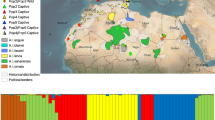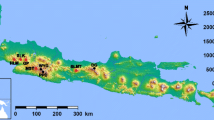Abstract
Boelen’s python (Morelia boeleni) is a montane New Guinea endemic found in highlands above 1000 m and below the tree line. The ecology, natural history, distribution, population size, and conservation status of this species are largely unknown. It has a protected status in Papua New Guinea but not in Indonesian Papua and several US and European zoos have active captive breeding programs that have been largely unsuccessful. To understand the degree of genetic diversity in wild and captive animals we undertook a genetic analysis of 90 M. boeleni for which we sequenced two mtDNA loci and one nuclear locus for a total of 1,418 bp of sequence data per individual. All 16 wild-caught M. boeleni from Indonesia and all captive M. boeleni are genetically uniform for all three loci. The single wild-caught animal from Papua New Guinea showed extremely low levels of genetic divergence and diversity from the Indonesian and captive samples. Data from two congeners, M. amethistina and M. viridis, suggests that M. boeleni have reduced genetic variation with a small effective population size possibly due to historical bottlenecks. These data demonstrate the need for further studies of genetic diversity of M. boeleni from across its range and raise particular concern for the limited genetic diversity of M. boeleni used captive breeding programs in zoological parks.



Similar content being viewed by others
References
Amos W, Balmford A (2001) When does conservation genetics matter? Heredity 87:257–265. doi:10.1046/j.1365-2540.2001.00940.x
Audley-Charles MG (1991) Tectonics of the New Guinea area. Annu Rev Earth Planet Sci 19:17–41. doi:10.1146/annurev.ea.19.050191.000313
Auliya M, Mausfeld P, Bohme W (2002) Review of the reticulated python (Python reticulatus Schneider, 1801) with the description of new subspecies from Indonesia. Naturwissenschaften 89:201–213. doi:10.1007/s00114-002-0320-4
Austin CC (2000) Molecular phylogeny and historical biogeography of Pacific island boas (Candoia). Copeia 2000:341–352. doi:10.1643/0045-8511(2000)000[0341:MPAHBO]2.0.CO;2
Austin CC, Hayden CJ, Bigilale I, Dahl C, Anaminiato J (2008) Checklist and comments on the terrestrial amphibian and reptile fauna from Utai, Northwestern Papua New Guinea. Herpetol Rev 39:40–46
Beehler BM (1993) Papua New Guinea conservation needs assessment. In: Beehler BM (ed) Mapping PNG’s biodiversity. Washington, DC, pp 193–209
Brongersma LD (1953) Notes on New Guinean reptiles and amphibians. II. Proc K Ned Akad Wet C 53:317–325
Brumfield RT, Beerli P, Nickerson DA, Edwards SV (2003) The utility of single nucleotide polymorphisms in inferences of population history. Trends Ecol Evol 18:249–256. doi:10.1016/S0169-5347(03)00018-1
Clark AM, Moler PE, Possardt EE, Savitzky AH, Brown WS, Bowen BW (2003) Phylogeography of the timber rattlesnake (Crotalus horridus) based on mtDNA sequences. J Herpetol 37:145–154. doi:10.1670/0022-1511(2003)037[0145:POTTRC]2.0.CO;2
Crowhurst PV, Hill KC, Foster DA, Bennett AF (1996) Thermochronological and geochemical constraints on the tectonic evolution of northern Papua New Guinea. In: Hall R, Blundell D (eds) Tectonic Evolution of Southeast Asia. Geological Society Special Publication No. 106
Daniels S, Heideman RN, Hendricks M, Wilson B (2002) A molecular phylogeny for the South African limbless lizard taxa of the subfamily Acontinae (Sauria: Scincidae) with special emphasis on relationships within Acontias. Mol Phylogenet Evol 24:315–323. doi:10.1016/S1055-7903(02)00217-8
Davies HL (1990) Structure and evolution of the border region of New Guinea. In: Carmen GJ, Carmen Z (eds) Petroleum exploration in Papua New Guinea: proceedings of the first PNG petroleum convention, Port Moresby
Dinerstein E, Wikramanyake ED (1993) Beyond “hotspots:” how to prioritize investments to conserve biodiversity in the Indo-Pacific region. Conserv Biol 7:53–65
Fajardo V, Gonzalez I, Martin I, Rojas M, Hernandez PE, Garcia T, Martin R (2008) Differentiation of European wild boar (Sus scrofa scrofa) and domestic swine (Sus scrofa domestica) meats by PCR analysis targeting the mitochondrial D-loop and the nuclear melanocortin receptor 1 (MC1R) genes. Meat Sci 78:314–322. doi:10.1016/j.meatsci.2007.06.018
Fuerst GS, Austin CC (2004) Population genetic structure of the Prairie Skink (Eumeces septentrionalis): nested Clade analysis of post Pleiostocence populations. J Herpetol 38:257–268. doi:10.1670/190-03A
Gray JE (1842) Description of some hitherto unrecorded species of Australian Reptiles and Batrachians. Zool Misc, London 5:1–57
Gray EM (1995) DNA fingerprinting reveals a lack of genetic variation in northern populations of the western pond turtle (Clemmys marmorata). Conserv Biol 9:1244–1255. doi:10.1046/j.1523-1739.1995.9051244.x
Harvey MB, Barker DG, Ammerman LK, Chippindale PT (2000) Systematics of pythons of the Morelia amethistina complex (Serpentes: Boidae) with the description of three new species. Herpetological Monogr 14:139–185. doi:10.2307/1467047
Hill KC, Gleadow AJ (1989) Uplift and thermal history of the Papuan fold belt, Papua New Guinea: apatite fission track analysis. Aust J Earth Sci 36:515–539. doi:10.1080/08120098908729507
Jordan PW, Goodman AE, Donnellan S (2002) Microsatellite primers for Australian and New Guinean pythons isolated with an efficient marker development method for related species. Mol Ecol Notes 2:78–82. doi:10.1046/j.1471-8286.2002.00135.x
Keogh JS, Barker DG, Shine R (2001) Heavily exploited but poorly known: systematics and biogeography of commercially harvested pythons (Python curtus group) in Southeast Asia. Biol J Linn Soc Lond 73:113–129. doi:10.1111/j.1095-8312.2001.tb01350.x
Kluge AG (2003) Aspidites and the phylogeny of pythonine snakes. Records of the Australian Museum, Supplement 19
Kretzmann MB, Gilmartin WG, Meyer A, Zegers GP, Fain SR, Taylor BF, Costa DP (1996) Low genetic variability in the Hawaiian Monk Seal. Conserv Biol 11:482–490. doi:10.1046/j.1523-1739.1997.96031.x
Lawson R, Slowinski JB, Brubrink FT (2004) A molecular approach to discerning the phylogenetic placement of the enigmatic snake Xenophidion schaeferi among the Alethinophidia. J Zool 263:285–294. doi:10.1017/S0952836904005278
Melville J, Schulte JA, Larson A (2004) A molecular study of phylogenetic relationships and evolution of antipredator strategies in Australian Diplodactylus geckos, subgenus Strophurus. Biol J Linn Soc Lond 82:123–138. doi:10.1111/j.1095-8312.2004.00324.x
Miller PS (1995) Selective breeding programs for rare alleles: examples form the Przewalski’s Horse and California Condor pedigrees. Conserv Biol 9:1262–1273. doi:10.1046/j.1523-1739.1995.9051262.x
Mittermeier RA, Mittermeier CG, Brooks TM, Pilgrim JD, Konstant WR, Da Fonseca GAB, Kormos C (2003) Wilderness and biodiversity conservation. Proc Natl Acad Sci USA 100:10309–10313. doi:10.1073/pnas.1732458100
Myers N, Mittermeier RA, Mittermeier CG, Da Fonseca GAB, Kent J (2000) Biodiversity hotspots for conservation priorities. Nature 403:853–858
O’Brian SJ, Roelke ME, Marker L, Newman A, Winkler CA, Meltzer D, Colly L, Evermann JF, Bush M, Wildt DE (1985) Genetic basis for species vulnerability in the Cheetah. Science 227:1428–1434. doi:10.1126/science.2983425
O’Shea M (1996) A guide to the snakes of Papua New Guinea. Independent Publishing, Independent Group Pty Ltd, Port Moresby, PNG
Plaisance L, Rousset V, Morand S, Littlewood DTJ (2008) Colonization of Pacific islands by parasites of low dispersal ability: phylogeography of two monogenean species parasitizing butterflyfishes in the South Pacific Ocean. J Biogeogr 35:76–87
Rawlings LH, Donnellan SC (2003) Phylogeographic analysis of the green python, Morelia viridis, reveals a cryptic species. Mol Phylogenet Evol 27:36–44. doi:10.1016/S1055-7903(02)00396-2
Rawlings LH, Rabosky DL, Donnellan SC, Hutchinson MN (2008) Python phylogenetics: inference from morphology and mitochondrial DNA. Biol J Linn Soc Lond 93:603–619. doi:10.1111/j.1095-8312.2007.00904.x
Rivera PC, Gardenal CN, Chiaraviglio M (2006) Sex-biased dispersal and high levels of gene flow among local populations in the argentine boa constrictor, Boa constrictor occidentalis. Austral Ecol 31:948–955. doi:10.1111/j.1442-9993.2006.01661.x
Rosenblum EB, Hoekstra HE, Nachman MW (2004) Adaptive reptile color variation and the evolution of the MC1R gene. Evolution Int J Org Evolution 58:1794–1808
Rosenblum EB, Hickerson M, Moritz C (2007) A multilocus perspective on colonization accompanied by selection and gene flow. Evolution Int J Org Evolution 61:12971–12985. doi:10.1111/j.1558-5646.2007.00251.x
Stuart BL, Rhodin AGJ, Grismer LL, Hansel T (2006) Scientific description can imperil species. Science 312:1137. doi:10.1126/science.312.5777.1137b
Theron E, Hawkins K, Bermingham E, Ricklefs RE, Mundy NI (2001) The molecular basis of an avian plumage polymorphism in the wild: A melanocortin-1-receptor point mutation is perfectly associated with the melanic plumage morph of the bananaquit, Coereba flaveola. Curr Biol 11:550–557. doi:10.1016/S0960-9822(01)00158-0
Tzika AC, Koenig S, Miller R, Garcia G, Remy C, Milinkovitch MC (2008) Population structure of an endemic vulnerable species, the Jamaican boa (Epicrates subflavus). Mol Ecol 17:533–544. doi:10.1111/j.1365-294X.2008.03967.x
Ursenbacher S, Carlsson M, Helfer V, Tegelstrom H, Fumagalli L (2006) Phylogeography and Pleistocene refugia of the adder (Vipera berus) as inferred from mitochondrial DNA sequence data. Mol Ecol 15:3425–3437. doi:10.1111/j.1365-294X.2006.03031.x
Utiger U, Schatti B (2004) Morphology and phylogenetic relationships of the Cyprus racer, Hierophis cypriensis, and the systematic status of Coluber gemonensis gyarosensis Mertens (Reptilia : Squamata : Colubrinae). Rev Suisse Zool 11:225–238
Vargas-Ramirez M, Chiari Y, Castano-Mora OV, Menken SBJ (2007) Low genetic variability in the endangered Colombian endemic freshwater turtle Podocnemis lewyana (Testudines, Podocnemididae). Contrib Zool 76:1–7
Vences M, Glaw F, Kosuch J, Bohme W, Veith M (2001) Phylogeny of South American and Malagasy boine snakes: molecular evidence for the validity of Sanzinia and Acrantophis and biogeographic implications. Copeia 4:1151–1154. doi:10.1643/0045-8511(2001)001[1151:POSAAM]2.0.CO;2
Acknowledgments
We thank the following museums, zoological parks, and individuals for donating genetic material for the genetic work: The Denver, Fort Worth, Houston, Milwaukee, Oklahoma City, Riverside, St. Louis, and San Diego Zoos as well as the Bishop Museum; A. Allison, J. Baylin, R. Beard, D. Bellis, N. Bottini, N. Hoover, M. Jodney, T. Koegen, Y. Kuto, J. Leware, R. Maugg, F. Memmo, J. Rosenstarch, O. Robert, G. Schiavino, B. Simpson, M. Smith, J. Sola, D. Taylor, K. Tepedelen, S. Wari and G. Womer. We thank B. Roy, V. Kula, and B. Wilmot from the PNG Department of Environment and Conservation, and J. Robins from the PNG National Research Institute who have provided research assistance in Papua New Guinea. This manuscript was improved from comments from the Austin lab group. This research was funded by National Science Foundation grants DEB 0445213 and DBI 0400797 to CCA.
Author information
Authors and Affiliations
Corresponding author
Appendix
Rights and permissions
About this article
Cite this article
Austin, C.C., Spataro, M., Peterson, S. et al. Conservation genetics of Boelen’s python (Morelia boeleni) from New Guinea: reduced genetic diversity and divergence of captive and wild animals. Conserv Genet 11, 889–896 (2010). https://doi.org/10.1007/s10592-009-9931-z
Received:
Accepted:
Published:
Issue Date:
DOI: https://doi.org/10.1007/s10592-009-9931-z




